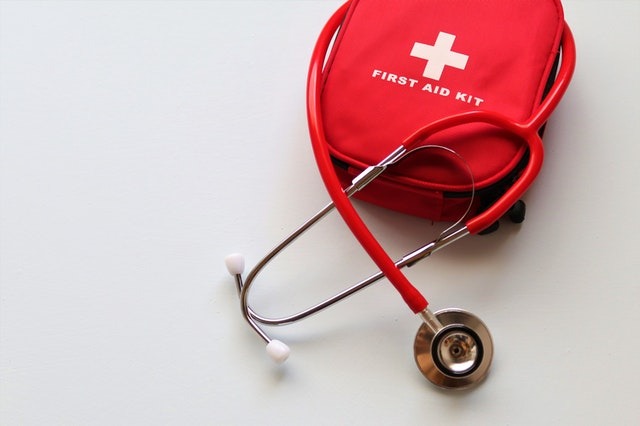
It is always critical to have first aid kits and to know basic first aid safety tips. Sooner or later, there will be an injury or an illness requiring first aid. This sort of incident may occur at home, your business or job, or somewhere else. Taking first aid courses will teach you possible lifesaving skills for such situations, but the following are basic first aid safety tips that everyone should know:
1. Have a Checklist for First Aid Kits
The following is the first aid kits’ checklist according to the CDC:
- First-aid guide
- Two Dressings
- 25 Assorted Size bandages
- Adhesive cloth tape
- Five ointment packets that are antibiotics
- Five packets of antiseptic wipes
- 2 aspirin packets
- A blanket
- A one-way valve breathing barrier
- A cold compress
- Two pairs of large, non latex gloves
- Two packets of hydrocortisone ointment
- A 3-inch gauze roll bandage
- A 4-inch wide roller bandage
- 5 3 x 3-inch sterile gauze pads
- 5 sterile gauze pads (4 x 4 inches)
- A non-glass/non-mercury thermometer
- Two Bandages (Triangular-shaped)
- Tweezers
2. First Aid Kit Customization
The first-aid kit checklist mentioned above includes the main things that should be in a first-aid kit. However, you should also put things together according to your family’s healthcare needs. For instance, you must include diabetic supplies, like glucose tablets, juice, and a glucagon injection kit, in your first aid kit, if someone in your family has diabetes.
3. Safety Always Comes First.
When there is an emergency situation requiring basic first aid tips, the first thing to do is to ensure the victim and others who are trying to help the person are safe.
4. Check to See Whether the Victim is Breathing and Awake or Conscious.
Check to see if the victim is breathing and awake or conscious will determine the next steps to take.
5. If Unconscious or Not Breathing, Obtain Medical Help via Phone.
If he/she is not breathing or conscious, get emergency help on the phone.
6. Make Sure Airflow is Unrestricted.
Then, make sure the airflow is unrestricted by ensuring nothing is in his/her mouth.
7. Administer CPR, if necessary and if trained to do it.
If CPR is needed, and you are not trained to do it, the healthcare person on the phone can instruct you how to administer it.
8. Determine if There’s External Bleeding.
Check for external bleeding and apply direct pressure if there’s any bleeding. Keep the person’s coverings on him/her while waiting for medical help to arrive.
9. If There are Burns, Immediately Stop Them and Treat Them.
If the person has burns, immediately stop the burns by running water on the affected area for five minutes.
10. Obtain Medical Help if The Person has Chemical or Severe Burns.
If the burns are chemical or severe, obtain medical help.
11. If Someone Has a Seizure, Obtain Emergency Medical Attention if the following Happens:
- He/she never had a seizure previously.
- Difficulty waking up or breathing after a seizure.
- A seizure lasting over five minutes.
- Another seizure happened after the first seizure
- The victim hurts while having a seizure.
- Having a seizure in water.
- The victim has a health condition.
12. Other Than That, Stay With Him/Her Until the Seizure Stops & He/She Completely Wakes.
Stay with him or her if the list above applies or not. Also, if the above doesn’t apply, stay with him/her until the seizure subsides, and the person completely wakes up.
13. After the Seizure Subsides, Help the Individual Safely sit up.
Help him or her to sit up in a safe area that supports his/her back and sides.
14. Tell the Person What Happened Once They are Alert and Can Talk.
Speak in a calm, comforting tone to the person.
15. Check to see if Emergency Information or a Medical Bracelet is on the Individual.
This information is valuable because it lets you know who to contact when this situation happens, and what information to tell the medical person over the phone.
16. Make Sure He/She can Safely get Home by Offering to Contact a Taxi or Someone Else.
This ensures he/she won’t risk getting into another episode while trying to drive.
17. If The Seizure is Major, i.e. Grand Mal or Generalized Tonic, (where he/she is shaking, jerking, and being unaware), do the following:
- Lie the person easily on the floor.
- Gently turn him/her on the side to help with breathing.
- Prevent possible injury, by removing hard, sharp objects from around the person, and removing his/her eyeglasses.
- Place something soft, like a blanket or the person’s jacket, under his/her head.
- Loosen any clothing from around his/her neck, like a scarf or tie.
- Time how long the seizure lasts.
As mentioned before, these are the basics that everyone should know. However, taking first aid courses will ensure you learn these basics and more.
Hey welcome to my blog . I am a modern women who love to share any tips on lifestyle, health, travel. Hope you join me in this journey!

Speak Your Mind